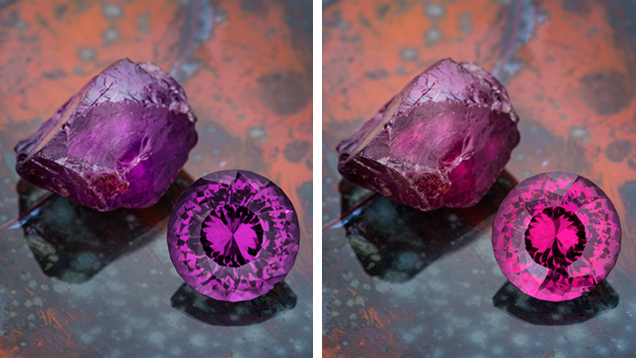Garnets, Sapphires, Opals, and Tarnish on High-Purity Gold

Amethyst purple under fluorescent equivalent lighting, hot pink under incandescent…
Welcome to the final Gems & Gemology of 2015. Colored gems—garnet, sapphire, and opal—are prominent in this issue. The Tanzanian garnet on our cover projects a rich, bold pink and demonstrates just how fine this material can be. It’s profiled in our lead article. The issue also offers insight into the origin of Montana’s alluvial sapphires, a gemological study of the historic Grand Sapphire, an investigation into tarnish spots on high-purity gold, and a field report on Australian opal.
Our first paper—by three of GIA’s young research scientists, Ziyin “Nick” Sun, Aaron Palke, and Nathan Renfro—examines interesting “color-change” pyrope garnet from Tanzania. Under fluorescent-equivalent lighting, larger gems have the color of fine purple amethyst, while under incandescent they resemble hot pink tourmaline. The authors provide a comprehensive review of this material’s inclusions along with a quantitative analysis of its color under different lighting conditions.
Alluvial sapphires from the U.S. state of Montana have long been celebrated for their kaleidoscope of colors, but so far no one has located these gems’ primary source rocks. In our second paper, a team of researchers led by Dr. J.C. “Hanco” Zwaan focuses on mineral inclusions and geochemistry to propose a metasomatic origin for Montana’s alluvial sapphires.
Next, Dr. François Farges and his colleagues profile the fascinating history and gemology of Louis XIV’s 135.74 ct Grand Sapphire, which was added to the French crown jewels in 1669, around the same time as the fabled Tavernier Blue diamond. On the basis of microscopic examination and spectroscopy, the authors suggest that this magnificent blue sapphire originated in Sri Lanka’s gem fields.
Our fourth paper investigates unsightly tarnish spots in high-purity (99.9% Au) gold jewelry. Dr. Taijin Lu and his team from the National Gems & Jewellery Technology Administrative Center (NGTC) in Beijing use a combination of advanced techniques to detect the presence of silver and sulfur in the tarnish spots. The authors recommend careful cleaning during the gold manufacturing process to eliminate the possibility of silver contamination.
In June 2015, a GIA team consisting of Tao Hsu, Andrew Lucas, and Vincent Pardieu visited four important opal fields at the rugged fringes of Australia’s arid Great Artesian Basin: Lightning Ridge, Koroit, Yowah, and Quilpie. Their field report documents mining activity and the growing importance of the revenue and employment brought to these remote outback communities by “opal tourism.”
As usual, you’ll find our regular Lab Notes and Gem News International sections along with the third installment of the Micro-World column. Our GNI section includes an update from field gemologist Vincent Pardieu on rubies from a new deposit in Zahamena National Park, Madagascar. There are also reports from the 2015 Geological Society of America (GSA) annual meeting in Baltimore, the first International Emerald Symposium in Bogotá, Colombia, and the 34th International Gemological Conference (IGC) in Vilnius, Lithuania.
Finally, you’ll notice this issue includes a ballot card for the Dr. Edward J. Gübelin Most Valuable Article Award. We had a fantastic response to our 2014 reader ballot, so please do vote again for your favorite 2015 articles.
Please enjoy the Winter issue!



